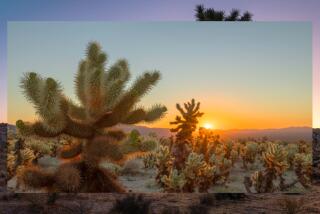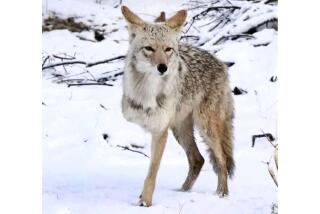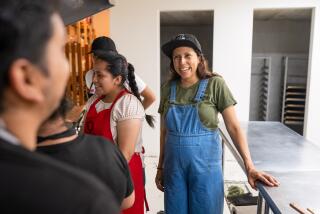Belize: Moments of jungle awe and ‘ah-ha!
RIGGO HERNANDEZ steered his palomino toward a smallish tree, plucked a leaf and held it over his head. “Smell one of these,” the guide hollered over his shoulder to our group of four riders.
I followed his lead and grabbed a long, oval leaf to sniff. I expected a woodsy, grassy or floral pungency. We were, after all, in the jungle.
“Pumpkin pie!” I blurted in surprise.
“Allspice,” Hernandez corrected.
An allspice tree might as well have been a pumpkin pie tree as far as I knew. I never before had stopped to consider that the spices in my kitchen cabinet came from somewhere outside of Whole Foods. What a thrilling little discovery -- the first of many, each more curious than the one before, on my December horseback-riding tour in this English-speaking Central American country.
For instance, in the Belizean wilderness grow medicinal plants with such eyebrow-raising names as jackass bitters (said to kill intestinal parasites). The haggard-looking gumbo-limbo tree is more often called the “tourist tree” because its red, peeling bark resembles sunburned visitors.
The rain-forest canopy rustles not only with birds and monkeys but also, on occasion, with machete-wielding men. These native chicleros slash zigzag patterns in sapodilla trees to release a natural sap containing chicle, an ingredient in chewing gum.
This addition of cultural intrigue made my weeklong trip an incomparable experience. For a horseback-riding trip among strangers to be a hit, there must be good-quality horses, breathtaking landscapes and amiable fellow riders. I’ve taken several such vacations, and all have delivered on the trifecta to varying degrees. But the outfitter on this trip, Mountain Equestrian Trails in Belize, upped the ante by melding an equestrian adventure with trips to Maya ruins.
Tourists generally come to Belize for its Caribbean beaches and barrier reef, the second-largest in the world. Cayo Province, on the western side of this Massachusetts-sized country, is known for Maya ruins -- esoteric caves deep in the rain forest as well as tourist-friendly ceremonial centers with informative guides. Our itinerary included both.
Most of Cayo’s 40,000 or so residents live in the “twin towns” of San Ignacio, home to the expansive and well-maintained Cahal Pech ruins and museum, and Santa Elena. The rest, including Mennonites who still practice their traditional way of life and a variety of ethnic groups, sparsely populate sprawling farms and villages.
A representative from Mountain Equestrian Trails waited for me at Belize International Airport. There, I also met the three other women on my tour, in their 30s. Although I had considerable riding experience, they had very little. But the disparity in skill wouldn’t be a problem, because it takes gumption more than finesse to trek steep, tortuous paths on unfamiliar horses.
These women were from Minnesota and were on their second annual horseback-riding vacation together. They had booked their trip through Hidden Trails, a Canada-based outfitter for equestrian and other outdoor vacations. I had made my arrangements through the Wyoming-based Equitours, which I found on the Web, simply because the Mayan Jungle Ride excursion fell on the dates I was available to travel.
Thanks to instant camaraderie and cheerful banter with the wonderfully brassy Minnesotans, the two-hour drive to the MET Lodge passed quickly.
Arran Bevis, the tan, blond 28-year-old who runs the 10-room lodge his parents built decades ago, showed us to our Maya-style cabanas: charming huts with palm-thatched roofs, tile floors, beds with hoop-style canopies of mosquito netting and lighted by kerosene lanterns instead of electric lamps. The cabanas’ bathrooms had toilets, hot showers, soap, towels and bottled water but no other amenities.
We generally spent downtime at the cantina, where guests gathered for beer, wine, cocktails and soft drinks (available for purchase) at the bar and around wooden tables for meals (included in the tour price).
That first night, after our long journey and a fair amount of local Belikin beer, we said good night at 8.
“Bed already!” Bevis said in surprise as he stood behind the bar, tinkering with the MP3s on his laptop. “Want me to check your rooms for spiders or anything like that?”
The Minnesotans took him up on the offer, but I didn’t because bugs weren’t particularly bothersome to me -- or so I thought at the time. I walked to my cabana and changed into flannel pajamas, necessary because the temperature had dropped from nearly 80 degrees during the day to the low 60s.
I awoke at 6:30 a.m. to a choir of birds outside. Wooden shutters instead of glass windows let in the wonderful avian sounds and, to my horror, many insects. When I opened my eyes, I found scores of bugs crawling on the netting enveloping me. It was as though I was in an episode of “Fear Factor.”
Holding my breath, I gingerly parted the netting so I wouldn’t cause a flurry of flapping wings, then bolted toward my suitcase, swiftly putting on jeans, hiking boots and a T-shirt, typical riding attire here.
Although breakfast wouldn’t be ready for a while, I went to the cantina anyway and lounged in the hammock, watching horses graze.
Morning meals usually included eggs, tortillas, fruit and coffee served around 8 a.m. An hour later, we headed for the small corral, where our sure-footed horses, a mix of quarter horse and regional stock, were already groomed and saddled.
We rode through rain forest, the foothills of the Maya Mountains and a pine savanna, which was recently devastated by an infestation of southern pine beetle. All that was left of the evergreens were tall, bare trunks, a surreal forest of telephone poles.
Hernandez, a gentle 36-year-old Guatemalan, spoke English well and smiled often. He was an excellent nature guide, educating us about the local flora and fauna. He whacked a white poisonwood tree with his machete to show us its seeping milky sap and cautioned us against touching the black poisonwood tree, which contains a clear sap that causes painful blistering, swelling and itching on contact. The antidote is a topically applied tea of water boiled with tourist-tree bark.
AT lunchtime, we tied our horses to trees and hiked seriously steep inclines to remote waterfalls. There, Hernandez set up our picnic spread, usually made up of leftovers from the previous night’s simple meal of chicken, shrimp, pasta, fruits and veggies and dessert. Sometimes we swam; other times we chatted on the rocky banks. After so much physical exertion in the tropical heat, nibbling in the cool mist of a waterfall was exhilarating.
But the truly singular experience -- better than any waterfall or gallop beneath giant palm fronds -- were the Maya ruins of Blancaneaux Cave.
During the late morning on Day 2, Hernandez took us to a clearing in the forest and dismounted. “We’re stopping here,” he said. “Take out your flashlights.”
I did as he said but wondered: Flashlights for what? The sun was shining.
Then Hernandez removed a rope from his saddlebag and tied it to the base of a tree.
“Who wants to go first?” he asked.
That’s when I saw the large hole in the forest floor.
No one volunteered, so Hernandez grabbed the rope and rappelled down into a cave about 10 feet underground.
I followed, learning the hard way that a short distance can take a long time when you don’t know what you’re doing. With my hands clinging to the rope, feet dangling in the air, I swung left and -- whap! -- hit the slimy limestone wall.
Eventually I found a few footholds and lowered myself into the cave -- but not before I hit the wall again, tearing the skin off one elbow and bruising a knee. Injuries aside, it was yet another thrilling first on this trip. My companions followed.
Hernandez led us through the cave, a winding but wide tunnel of stalactites and stalagmites. The air was thick and stagnant, and my heart pounded hard from a combination of claustrophobia, humidity and awe. Hernandez pointed out ledges where the Maya elite presided over ceremonies and discussed civic matters. He guided us through passageways that separated rooms, all the while sharing bits of Maya history, which I found the most interesting of all.
Maya originated around 2600 BC, rose to prominence around AD 250 and declined in AD 900. They were an advanced civilization, even by our standards, developing astronomy, complex mathematical systems, accurate calendars and ceremonial architecture that have survived looting and the elements.
Using hieroglyphics, they were also the first people of the New World to keep historical records. It struck me that their civilization was virtually as complex and resourceful as modern civilization, and they accomplished this with few of the resources of today -- not even metal tools.
In the push of everyday life, there’s little time to pause for this kind of reflection, to look down at the giants’ shoulders beneath our feet.
That’s what Blancaneaux Cave -- and other parts of my riding tour -- did for me. Since I returned home, I haven’t looked at my calendar without thinking of the Maya. And I doubt I’ll taste pumpkin pie again without thinking of Belize.
*
Begin text of infobox
Saddle up
GETTING THERE:
From LAX, Continental, American and Taca have connecting service (change of plane) to Belize City. Restricted round-trip fares begin at $387.
RIDING TOURS:
Mountain Equestrian Trails, 604 Maple St., Nokomis, FL 34275-2429; (800) 838-3918 or (941) 488-0522, https://www.metbelize.com . A five-night package in high season, Dec. 15-April 30, is $1,095 per person, double occupancy, including transportation to and from Belize City airport, riding, meals and lodging in clean, thatch-roofed cabanas (no air conditioning). Airfare from the U.S. is extra. The outfitter also offers lodging without the riding package: cabanas for two, $120 a night. But if you’re not there for the riding experience, there’s not much to do except hang out in the cantina hammock and read a book. Simple, eat-what-they-serve breakfasts, lunches and dinners are $7-$18. Riding and guided treks also available on a separate-charge basis.
Among other companies offering riding tours to the Cayo district:
Equitours, 10 Stalnaker St., Dubois, WY 82513; (800) 545-0019 or (307) 455-3363, https://www.ridingtours.com . Five-night Maya jungle ride tour is $1,095 per person, double occupancy, including airport transfers, lodging, all meals and riding. Airfare from the U.S. is extra. Extended tour into Guatemala also available for $1,470 per person, double occupancy.
Hidden Trails, 659A Moberly Road, Vancouver, Canada V5Z 4B3; (888) 9-TRAILS (987-2457), https://www.hiddentrails.com . Five-night Maya jungle ride package is $1,145 per person, double occupancy, including transfers from Belize City airport, lodging, meals and riding. Airfare from the U.S. not included.
TO LEARN MORE:
Belize Tourism Board, (800) 624-0686, https://www.travelbelize.org .
More to Read
Sign up for The Wild
We’ll help you find the best places to hike, bike and run, as well as the perfect silent spots for meditation and yoga.
You may occasionally receive promotional content from the Los Angeles Times.






